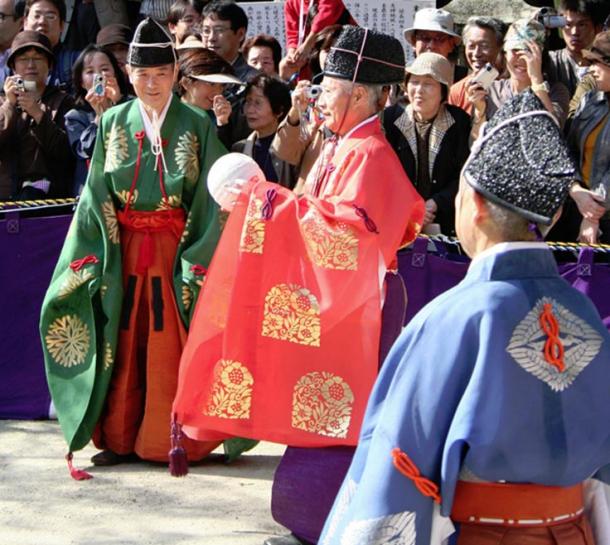Kemari: Revival of a 7th Century Japanese Football Game in Modern Times
Kemari is an ancient ball game that has its origins in Japan, and has some similarities to the modern sport known as association football (more commonly known as football in the UK or soccer in the US).
Association football, which is one of the most popular sports today, is said to have obtained its present form in England in 1863, when rugby football and association football branched off on their different courses. This was also the year when the Football Association in England, the sport’s first governing body, was formed.
By comparison, kemari has been around since the 7th century AD, though it was only several centuries later that its rules were standardized.
Kemari’s Early Days
Kemari was introduced into Japan by China at some point of time prior to 644 AD. One of the earliest references to this game can be found in the Nihon Shoki, the second oldest book of classical Japanese history.
According to this historical source, a game of kemari was played at Hôkôji in Nara in 644 AD. One of the players was Prince Nako no Ôe (who would later become Emperor Tenji). During the game, the prince’s shoe flew off. Seeing this, another player, Nakatomi (later Fujiwara) no Kamatari, picked up the shoe, and brought it to the prince. This was an important event because the two became good friends, and together instrumented the downfall of the powerful Soga clan in the following year.

Page from a copy of the Nihon Shoki, early Heian period (Public Domain)
- The Last of the Charrua: The Honored Warrior Tribe of Uruguay
- Kamikaze – The Divine Winds that Saved Japan
How Kemari is Played
In China, a football-like sport known as cuju is said to have had existed since the Warring States period (476 BC – 221 BC). Cuju was a violent sport and it was used for the training of military personnel. Over time, standardized rules were established for the game, and whilst its violent nature was reduced as it spread from the military to the other social classes, its competitive nature was maintained.

Chinese ladies playing cuju, by the Ming Dynasty painter Du Jin. (Public Domain)
When this game arrived on the shores of Japan, it seemed to have changed quite radically, based on the way kemari is played today. For a start, the competitive nature of the game was shed. For instance, the goal of cuju, similar to modern football, was to kick a ball (without the use of hands) through an opening into a net. The goal of kemari, however, was to keep a ball from touching the ground for as long as possible using various parts of the body apart from the hands.
Unlike cuju and football, there were neither winners nor losers when kemari was played. In each game, there would be between six to eight players. Typically, there were four primary players, and up to four assistants. These players had to work together to keep the ball in the air for as long as they were able to, thus emphasizing the co-operative nature of the sport.
Another difference between kemari and its Chinese predecessor is the group of people who first played the sport. Whilst it was the military class who started playing cuju in China, in Japan, it was the upper class who first played kemari. For the members of the ancient Japanese upper class, kemari was regarded as a refined game of skill and grace.
During the Kamakura period (between the 12th and 14th centuries), kemari had become a popular sport amongst the samurai class. By the Edo period (between the 17th and 19th centuries), the appeal of this ball game had spread to the masses. After the Meiji restoration, however, the popularity of kemari declined, much to the displeasure of the Emperor Meiji.

Modern Kemari festival at Tanzan Shrine, Nara city, Nara Prefecture, Japan (CC BY-SA 3.0)
- The Seven-Branched Sword: The Mystical Ceremonial Sword of Japan
- Operation Awa - giving the forest back to one of the most endangered tribes on the planet
This prompted the Japanese ruler to establish the Kemari Hôzô Kai, or ‘Kemari Preservation Society’. Thanks to the efforts of the emperor, kemari has survived until today. Although this game has not regained the popularity it once had, it is kept alive through two special events that are held annually. The first of these is the kemari hajime, or ‘first kick’, which is held on New Year’s Day at the Shimogamo Shrine, a Shinto shrine located in Kyoto. The second is the kemari festival that is held in November at Nara, the ancient Japanese capital.
Featured image: A modern game of kemari at the Tanzan Shrine, Japan. Photo source: (CC BY-SA 3.0)
By Ḏḥwty
References
Bryant, A. J. & Badgley, J. L., 2014. Kemari. [Online]
Available at: http://www.sengokudaimyo.com/miscellany/kemari.html
FIFA, 2002. Kemari – an alternative way to play football. [Online]
Available at: http://www.fifa.com/theclub/news/newsid=81248/
FIFA, 2016. History of Football - The Origins. [Online]
Available at: http://www.fifa.com/about-fifa/who-we-are/the-game/index.html
Hongo, J., 2014. Kemari: a whole old ball game. [Online]
Available at: http://www.japantimes.co.jp/culture/2014/01/02/events/events-outside-tokyo/kemari-a-whole-old-ball-game/#.VqC_IPl97ce
Ministry of Culture, P.R. China, 2003. Ancient Chinese Football. [Online]
Available at: http://www.chinaculture.org/gb/en_chinaway/2004-04/28/content_46847.htm
RoninDave, 2012. Kemari – Ancient Japanese Soccer / Football. [Online]
Available at: http://www.tokyotimes.com/kemari-ancient-japanese-soccerfootball/
The Imperial Household Agency, 2016. Kemari (Ancient football game of the Imperial Court). [Online]
Available at: http://www.kunaicho.go.jp/e-culture/kemari.html



















